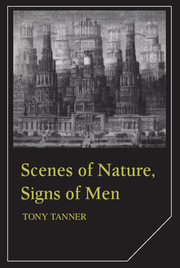Book contents
- Frontmatter
- Contents
- Preface
- 1 Scenes of nature, signs of men
- 2 Notes for a comparison between American and European Romanticism
- 3 Problems and roles of the American artist as portrayed by the American novelist
- 4 James on Hawthorne
- 5 The lost America – the despair of Henry Adams and Mark Twain
- 6 Henry James and Henry Adams
- 7 William Dean Howells and A Hazard of New Fortunes
- 8 Stephen Crane
- 9 The Bostonians and the human voice
- 10 Games American writers play: ceremony, complicity, contestation, and carnival
- 11 Toward an ultimate topography: the work of Joseph McElroy
- 12 Frames and sentences
- 13 William Gass's barns and bees
- Index
7 - William Dean Howells and A Hazard of New Fortunes
Published online by Cambridge University Press: 01 June 2011
- Frontmatter
- Contents
- Preface
- 1 Scenes of nature, signs of men
- 2 Notes for a comparison between American and European Romanticism
- 3 Problems and roles of the American artist as portrayed by the American novelist
- 4 James on Hawthorne
- 5 The lost America – the despair of Henry Adams and Mark Twain
- 6 Henry James and Henry Adams
- 7 William Dean Howells and A Hazard of New Fortunes
- 8 Stephen Crane
- 9 The Bostonians and the human voice
- 10 Games American writers play: ceremony, complicity, contestation, and carnival
- 11 Toward an ultimate topography: the work of Joseph McElroy
- 12 Frames and sentences
- 13 William Gass's barns and bees
- Index
Summary
‘The most vital of my fictions’, wrote Howells of A Hazard of New Fortunes; and certainly this book, finished in 1889 when Howells was 52, represents the peak of his achievement as a novelist. It was also the full flowering of certain changes which had come about in his life (and hence in his fiction) since 1886; and to appreciate his achievement up to that date it is useful to turn to an essay by Henry James, summing up Howells's contribution to American literature, and written in 1886, just before the changes commenced. James praises Howells's ‘unerring sentiment of the American character’ and notes admiringly his capacity to ‘feel’ and respond to the quality of contemporary American life. ‘I will not say that Mr. Howells feels it all equally, for are we not perpetually conscious how vast and deep it is? – but he is an authority upon many of those parts of it which are most representative.’ He then stresses the strong documentary bias in Howells's work – ‘I know of no English novelist of our hour whose work is so exclusively a matter of painting what he sees, and who is so sure of what he sees’ – and welcomes it in these terms: ‘His work is of a kind of which it is good that there should be much today – work of observation, of patient and definite notation.’
- Type
- Chapter
- Information
- Scenes of Nature, Signs of MenEssays on 19th and 20th Century American Literature, pp. 111 - 132Publisher: Cambridge University PressPrint publication year: 1987

